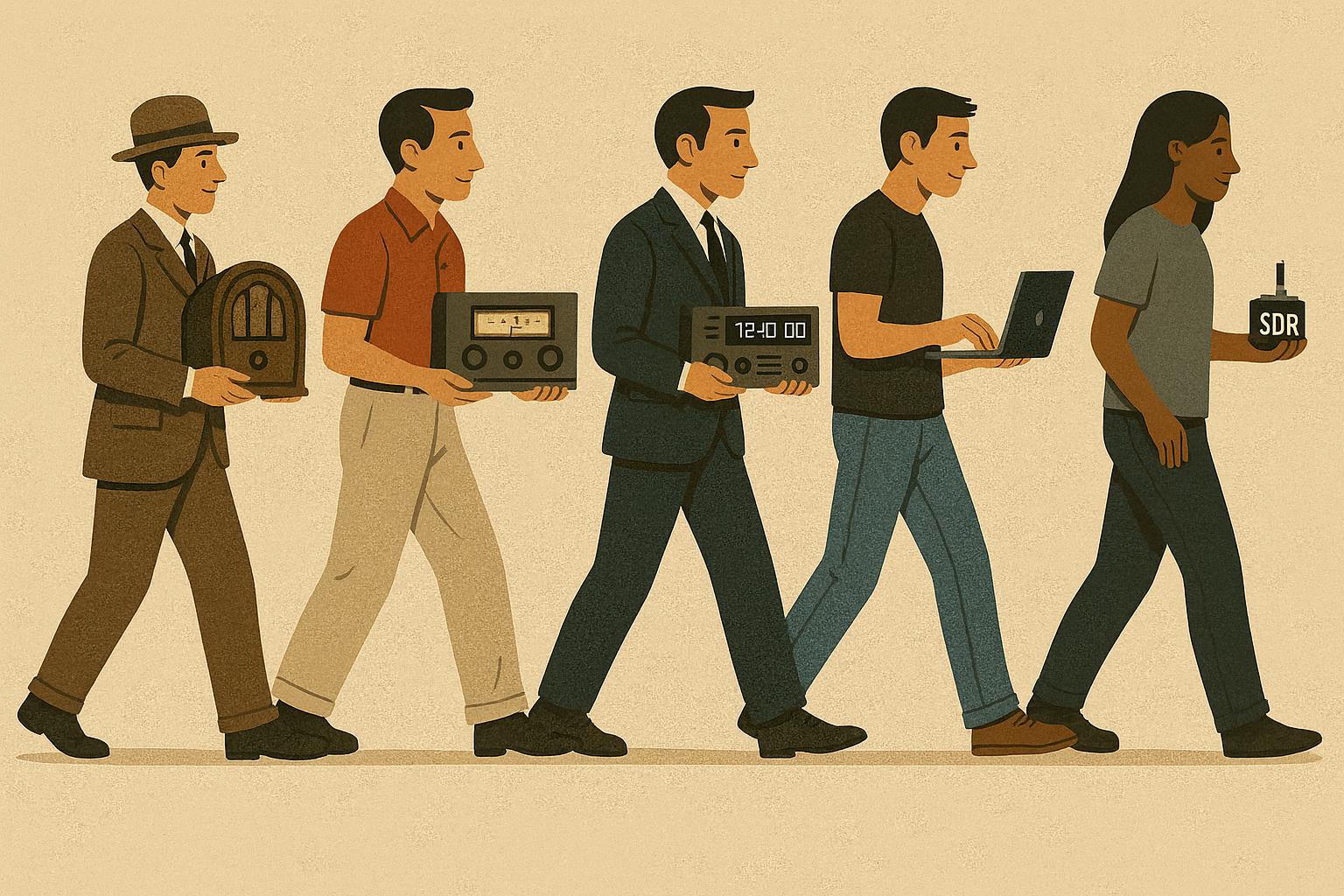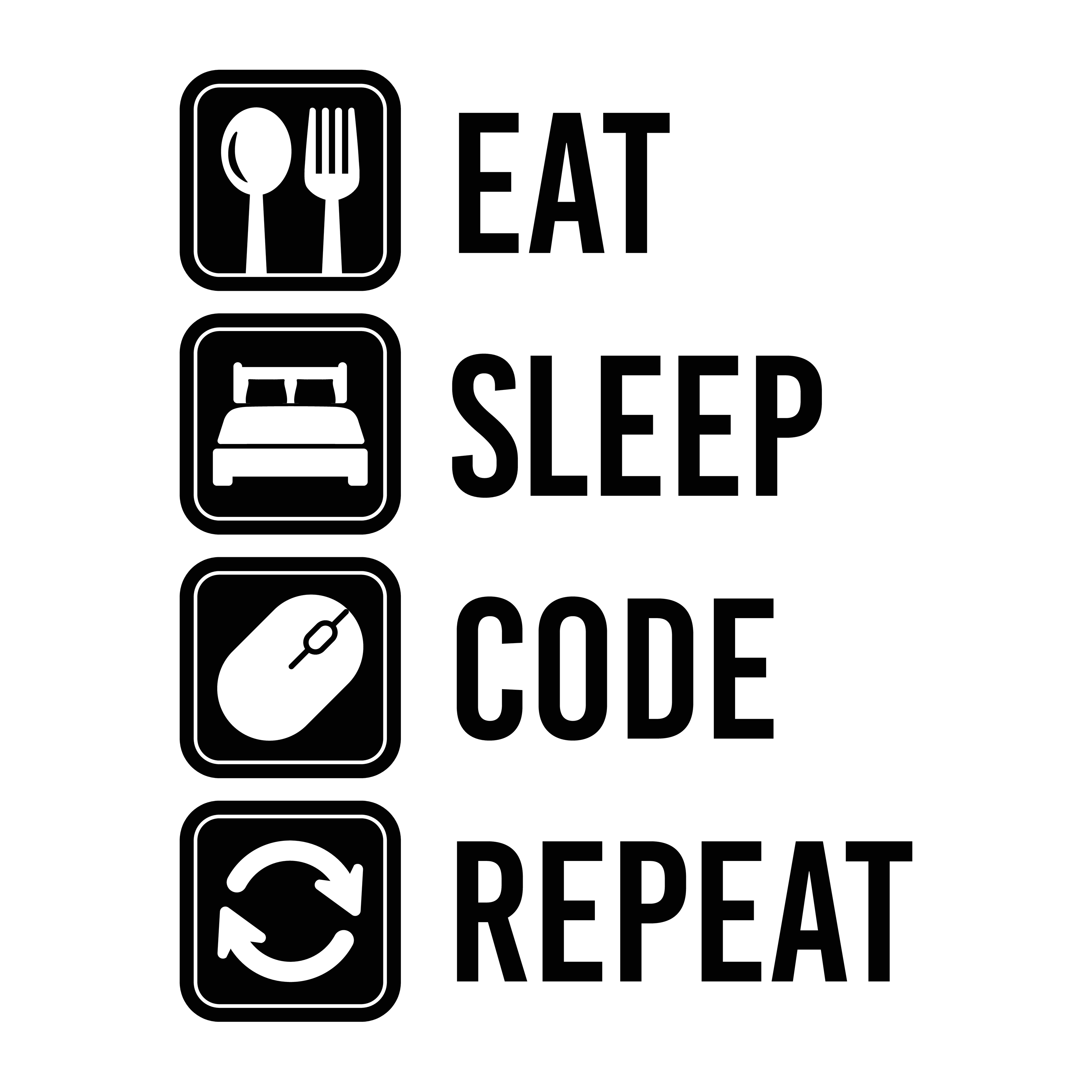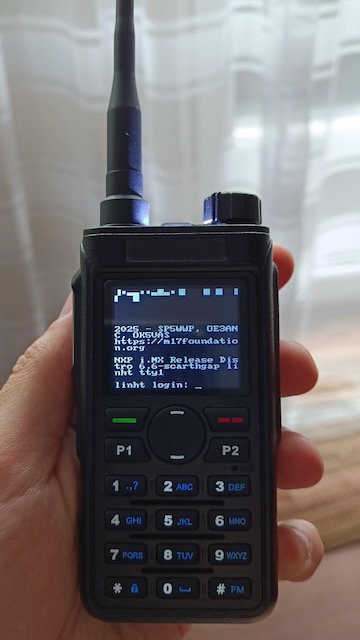Latest Awards
Trials and Errors #64 (8/24/25): Tech-Focused Hams -- A Shot Across the Bow to ICOM, Yaesu and More
(Las Vegas, August 2025.) Thousands of hackers and IT pros meet for DEFCON 2025. There's a quiet room off to the side of the convention center where behind closed doors, KB6NU's training session is taking place. The room is full-up. . . It's a one-day ham radio licensing course, followed by a licensing exam. And shortly thereafter, 32 newly licensed ham radio operators join the amateur radio services.
There's a not-so-subtle change happening within the ranks of radio amateurs. New hams are coming into the hobby, but not for the same reasons that you and I had years ago. And these "new" hams have the potential of upending the market for products sold by the old guard -- companies such as ICOM and Yaesu.
Do you remember how cool it was to talk to someone on the other side of the planet, and how this enticed you to save your pennies for that first radio? For me, and countless other young people of decades past, that was the dream . . . a station of our own to reach other operators in world locations.
While there will always be those who are turned on by this same idea, the cell phone and our ability to just dial up anyone, anywhere, has taken a lot of the oomph out of that intrigue. I've found in several outings of my own to demonstrate amateur radio that I often get worn out answering visitors' questions about "Why do you want all of these gadgets when you can just reach that person with the phone in your pocket?"
Will that kill the amateur radio pursuit? Not at all. But that may be because there is another, completely separate (and fast-growing) element of interest in radio from a different community entirely. And that community could soon eclipse the current RF-focused amateur radio crowd. Whether you like it or not.
 RF-Focused Ham Radio versus Tech-Focused Ham Radio
RF-Focused Ham Radio versus Tech-Focused Ham Radio
Of course, anything that we refer to as 'radio' is going to have an RF element in it. In last month's column about my better-late-than-never introduction to digital, it was clear that the world of amateur radio is split on opinions of whether it's 'really ham radio' to QSO with someone on another continent through a series of repeaters or a hot spot.
Let's set that argument aside for a moment and instead go back to a strict definition of our practice, and just what -- exactly -- we're supposed to be doing with those licenses of ours. This one is adapted from a Google AI overview of what we do, and is quite a bit like the FCC dictum:
"Ham radio involves hobbyists using technology to learn, innovate, and push the boundaries of communication, leading to the development of new techniques and applications like RF-based networks and crowd-sourced scientific or engineering investigations. This culture is characterized by a hands-on, DIY approach, with amateurs building equipment, adapting new technologies, and even conducting experiments or writing useful code for new communication modes. It fosters technical skill, encourages problem-solving, and contributes to the broader technical landscape by challenging established norms and exploring new possibilities."
This definition doesn't mean that I am not fulfilling my A.R. obligations just because I enjoy a leisurely rag-chew on 20 meters with my Plug 'n Play radio. I have plenty of my own experimentation, generally centered around propagation and the fine-tuning of one antenna or another. But that definition DOES leave plenty of room for a new type of ham, one who comes in from the tech side of the RF/Tech equation, perhaps even from the IT world. And this is what has shocked me most recently . . . finding that there are so many young people with an interest in IT and programming who would like to combine that with the fun of electronics and designing new communication tools that, as the definition states, "challenge established norms."
This can be a bit of a rude shock, because you may be like me. I'm a guy who lives with and loves those established norms.
Where Are These New Tech-Focused Hams Coming From?
In 2024, I was asked to write an editorial for the ARRL journal On the Air (May/June 2024, "Points of Connection.") While working on that piece I discovered something that eventually triggered this column. It was a short article about the pleasures of being involved in a hobby activity that included people of all age groups. And while I was writing that, I discovered that the young people I was speaking to were engaged in ham radio through a different interest mechanism than me. At local events, I would talk up my latest DX conquest on HF but these folks were talking about modes like VARA or M17, discussing something they'd seen being developed in the open source world. I couldn't even participate in those conversations, but I noticed how passionate they were about what they were doing. Just like I was as a young guy building a Heathkit and getting on 40 meters.
 Recently in an email exchange I had with Steve Stroh (N8GNJ -- author of the Zero Retries newsletter) we discussed this new group of hams.
Recently in an email exchange I had with Steve Stroh (N8GNJ -- author of the Zero Retries newsletter) we discussed this new group of hams.
"I think those digital/data modes are “skating where the puck is going to be” for the current generation of new hams that is quietly -- even stealthily -- coming into Amateur Radio," Steve told me. "Those 'NewTechHams' that I’ve been taking note of in Zero Retries are coming from software development, makers, engineering students, IT professionals, and so on, and they have a very different agenda within Amateur Radio than our generation. They think, "I need a new radio, so I’ll sit down and write one . . . an SDR."
Steve and I agree on the fact that these new hams are nearly invisible to many elements of the hobby. [As an aside, his term "NewTechHams" has nothing to do with the Technician Class ham license . . . it's entirely because they are "tech," or IT, focused.]
"Yes, invisible! Especially to the ARRL and conventional Amateur Radio activities because they want to explore 'the geeky side of digital radio' and thus learn, hands-on, about radio technology. They’re not joiners of organizations like the ARRL, and they aren’t subscribers of magazines. In fact, they aren’t contesters, or DXers, or… much of anything conventional. If Amateur Radio is to have a future, it will be because this generation of techies can be convinced to join and support and expand Amateur Radio," Steve concluded.
His use of the phrase "geeky side of digital radio" was Steve's mild poke at the way I've described this part of amateur radio in the past on Trials and Errors. I forgive him for his teasing.
Examples of NewTechHams and Their Interests
I've written before about some of the new wave of hams, and the two that come to mind most readily are Sean Lynch (KK6BEB) and Dmitry Panin (UA3REO). There's some common ground between these two, in that they are both "makers" who have built products or businesses successfully in the past. In Sean's case, he built a valuable cloud services company that was purchased by a Fortune 100 organization. He then turned his resources to ham radio, as he had ideas for improvements in how repeaters are managed and how on-the-air nets are run. His free software is a gift to our hobby, and my guess is that Sean has several other ideas in the works as he's a "NewTechHam" and little can hold these folks back. See that earlier article here.
 Dmitry was the subject of an article in T&E about how copycats can 'steal' open source ideas and try to commercialize them. But when it's done in a sub-standard way, as the Chinese did with Dmitry's WOLF RADIO project, it can risk the entire idea and stop advancement. Luckily, Dmitry persisted with his open source project, moving it into a much more private sphere. We will soon see the results of his team's efforts in a new radio from the Lab599 people, the designers and marketers of the TX-500 QRP portable transceiver. I'm proud to note this collaboration was suggested by QRZ.com in that interview with Dmitry and he took us up on it, ultimately moving the WOLF into the Lab599 company as a TX-1000 transceiver (with a 2025 release date). If it performs as promised, it should really rock the hallways of companies like ICOM, Yaesu and more. It's a UHF/VHF/HF SDR transceiver with a host of features that come from the core of those NewTechHams that Dmitry worked with in the open source environment.
Dmitry was the subject of an article in T&E about how copycats can 'steal' open source ideas and try to commercialize them. But when it's done in a sub-standard way, as the Chinese did with Dmitry's WOLF RADIO project, it can risk the entire idea and stop advancement. Luckily, Dmitry persisted with his open source project, moving it into a much more private sphere. We will soon see the results of his team's efforts in a new radio from the Lab599 people, the designers and marketers of the TX-500 QRP portable transceiver. I'm proud to note this collaboration was suggested by QRZ.com in that interview with Dmitry and he took us up on it, ultimately moving the WOLF into the Lab599 company as a TX-1000 transceiver (with a 2025 release date). If it performs as promised, it should really rock the hallways of companies like ICOM, Yaesu and more. It's a UHF/VHF/HF SDR transceiver with a host of features that come from the core of those NewTechHams that Dmitry worked with in the open source environment.
Another example of a Tech-Focused ham project is the M17 digital voice protocol, which can be used to replace proprietary modes like D-Star, System Fusion, or DMR. Bruce Perens (K6BP) a well-known amateur radio operator and open source advocate, describes M17 as proof that open source development "stands for the rejection of black-box technology." In other words, instead of being forced to use a codec like the one that is used in every single digital voice mode (ABME), we can replace it with "something that hams own -- and that's worth fighting for." What kind of ham developed this technology? It was, of course, the Tech-Focused amateur radio operators who come from a world of IT and programming and not from the typical radio-interest ladder.
 The fellow who began that M17 journey through open source development was Wojciech Kaczmarski (SP5WWP) of Poland. Wojciech won the ARRL Technical Innovation Award in 2021, and he's the classic example of a NewTechHam. As to be expected, he's now off on another ham radio open source mission -- this one called called LinHT.
The fellow who began that M17 journey through open source development was Wojciech Kaczmarski (SP5WWP) of Poland. Wojciech won the ARRL Technical Innovation Award in 2021, and he's the classic example of a NewTechHam. As to be expected, he's now off on another ham radio open source mission -- this one called called LinHT.
LinHT is another project that should kickstart some thinking in Japan . . . it's a hardware platform capable of running new, experimental, and modified voice communication modes. (Photo at right shows LinHT in the body of a Retevis HT).
Bruce Perens describes it this way on his blog, "LinHT is the most important hardware project in Amateur Radio today. Among other things, it is the perfect platform to run a variant of RADE on VHF/UHF. (RADE may just be the future of voice, all voice, on Amateur Radio.) It integrates what we used to use a CODEC and MODEM for into one unified component powered by machine learning, which is the non-hype version of AI. In tests, it works at a significantly lower signal-to-noise ratio than analog voice modes, even SSB, and legacy digital modes like D*STAR and DMR, while providing better fidelity, noise immunity, and fade resistance."
Worth Fighting For
I would agree with K6BP when Bruce states that much of what these NewTechHams are working on is "worth fighting for," because I want to see true innovation happen faster in amateur radio, and I don't think we'll EVER get there if we rely solely on the major manufacturers.
In closure, let me use a paragraph of an open letter that Wojciech posted, which has circulated around the GitHub community. In that open letter, SP5WWP describes what should change in the way that open source development proceeds. He suggests a way that major companies could utilize some of that wonderful NewTechHam prowess in coding and development (because the status quo is not giving us the level of advancement that we should be expecting in technology today). Here's how he describes it in his open letter:
"It’s no secret that most of the amateur radio community depends upon large companies like Icom, Yaesu, and Kenwood to offer us our needed solutions. In the commercial environment, the status quo is all about ensuring that hardware and software is kept proprietary, however. This minimizes the user’s abilities to modify it. While there are new models of radios being advertised all the time, it is rare that those bring anything truly new. This keeps the amateur radio world in a state of artificially sustained technological stagnation, which is extremely short-sighted as it dampens our progress for the sole reason of maximizing company profits." (In order to fully grasp his world view of the importance of this type of innovation, please do click on the link above and read his open letter.)
That technological stagnation also leaves a gigantic "hole" into which others can enter the amateur radio services and truly make a substantial impact. Whether it's through a new radio like Dmitry's, a protocol like M17 or an advanced hardware set based on LinHT, perhaps we will see soon the results of how the age of NewTechHams has impacted our hobby.
73 for now, Dave W7DGJ


























